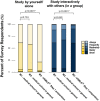Brave new E-world: Medical students' preferences for and usage of electronic learning resources during two different phases of their education
- PMID: 35520393
- PMCID: PMC9065580
- DOI: 10.1096/fba.2021-00124
Brave new E-world: Medical students' preferences for and usage of electronic learning resources during two different phases of their education
Abstract
E-learning strategies have become an important part of biomedical education. However, why and how medical students select hardware tools and software formats during their preclinical education has not been sufficiently evaluated. These aspects should be considered when designing or offering new e-learning modalities to learners. Two medical school classes at a major US medical school were surveyed about their use of e-learning resources during their first year of medical school or their preparation for their first licensing examination (USMLE® Step 1), respectively. Their responses were analyzed for patterns and significant changes. Students' answers indicated that computers and tablets were considered the most important hardware devices to support students' learning. During the first year, students often preferred resources that were tailored to the specific courses in their curriculum. In contrast, some preferences changed when students prepared for the USMLE Step 1, with students shifting almost exclusively to a solitary learning strategy using commercial e-learning resources. Across all phases of medical school education queried, peer advice was the major determinant influencing e-learning resource selection with faculty only playing a minor role. Videos were the most popular e-learning modality, and students cited efficient acquisition of knowledge and preparation for examinations as major reasons for e-learning tool utilization. These factors should be considered when offering e-learning resources to medical students during different phases of their preclinical training.
Keywords: USMLE; e‐learning; learning resources; preclinical medical education; technology‐enhanced learning; user preferences.
© 2021 The Authors. FASEB BioAdvances published by Wiley Periodicals LLC on behalf of The Federation of American Societies for Experimental Biology.
Conflict of interest statement
The authors declare no conflict of interest.
Figures


Similar articles
-
The Double-Edged Sword of Third-Party Resources: Examining Use and Financial Burden of Extracurricular Tools in Medical Students.MedEdPublish (2016). 2025 Jan 2;14:4. doi: 10.12688/mep.20120.2. eCollection 2024. MedEdPublish (2016). 2025. PMID: 39803636 Free PMC article. Review.
-
Gender differences in learning and study strategies impact medical students' preclinical and USMLE step 1 examination performance.BMC Med Educ. 2024 May 7;24(1):504. doi: 10.1186/s12909-024-05494-z. BMC Med Educ. 2024. PMID: 38714975 Free PMC article.
-
Environments, processes, and outcomes - using the LEPO framework to examine medical student learning preferences with traditional and electronic resources.Med Educ Online. 2021 Dec;26(1):1876316. doi: 10.1080/10872981.2021.1876316. Med Educ Online. 2021. PMID: 33499778 Free PMC article.
-
Perspectives of Nonphysician Clinical Students and Medical Lecturers on Tablet-Based Health Care Practice Support for Medical Education in Zambia, Africa: Qualitative Study.JMIR Mhealth Uhealth. 2019 Jan 15;7(1):e12637. doi: 10.2196/12637. JMIR Mhealth Uhealth. 2019. PMID: 30664475 Free PMC article.
-
Flashcards: The Preferred Online Game-Based Study Tool Self-Selected by Students to Review Medical Histology Image Content.Adv Exp Med Biol. 2023;1406:209-224. doi: 10.1007/978-3-031-26462-7_10. Adv Exp Med Biol. 2023. PMID: 37016117 Review.
Cited by
-
Learning together: a narrative review of external resources for medical education through a shared student-faculty lens.Ann Med. 2025 Dec;57(1):2483971. doi: 10.1080/07853890.2025.2483971. Epub 2025 Mar 28. Ann Med. 2025. PMID: 40152754 Free PMC article. Review.
-
Implementing PathElective as an organized means of supplementing pathology education in an osteopathic medical school-the New York Institute of Technology College of Osteopathic Medicine experience.Acad Pathol. 2024 May 21;11(2):100122. doi: 10.1016/j.acpath.2024.100122. eCollection 2024 Apr-Jun. Acad Pathol. 2024. PMID: 38812825 Free PMC article.
-
Teaching Histology Using Self-Directed Learning Modules (SDLMs) in a Blended Approach.Med Sci Educ. 2022 Nov 7;32(6):1455-1464. doi: 10.1007/s40670-022-01669-9. eCollection 2022 Dec. Med Sci Educ. 2022. PMID: 36407816 Free PMC article.
-
Educational Videos Versus Question Banks: Maximizing Medical Student Performance on the United States Medical Licensing Examination Step 1 Exam.Cureus. 2023 Apr 25;15(4):e38110. doi: 10.7759/cureus.38110. eCollection 2023 Apr. Cureus. 2023. PMID: 37252516 Free PMC article.
-
The Double-Edged Sword of Third-Party Resources: Examining Use and Financial Burden of Extracurricular Tools in Medical Students.MedEdPublish (2016). 2025 Jan 2;14:4. doi: 10.12688/mep.20120.2. eCollection 2024. MedEdPublish (2016). 2025. PMID: 39803636 Free PMC article. Review.
References
-
- Ruiz JG, Mintzer MJ, Leipzig RM. The impact of E‐learning in medical education. Acad Med. 2006;81:207‐212. - PubMed
-
- Ellaway R, Masters K. AMEE Guide 32: e‐Learning in medical education Part 1: learning, teaching and assessment. Med Teach. 2008;30:455‐473. - PubMed
-
- Masters K, Ellaway R. e‐Learning in medical education Guide 32 Part 2: technology, management and design. Med Teach. 2008;30:474‐489. - PubMed
-
- Kumar Basak S, Wotto M, Belanger P. E‐learning, M‐learning and D‐learning: conceptual definition and comparative analysis. E‐Learn Digital Media. 2018;15:191‐216.
-
- Hortsch M. “How we learn may not always be good for us” ‐ do new electronic teaching approaches always result in better learning outcomes? Med Teach. 2015;37:507‐509. - PubMed
LinkOut - more resources
Full Text Sources
